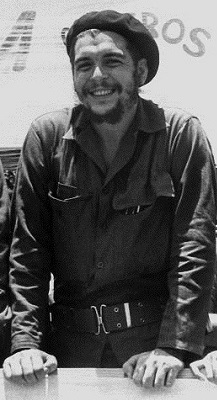|
~ Ernesto Che Guevara
~ Galéria
~ Oldal
~ Bejelentkezés
~ Vissza a Főoldalra
Ernesto Che Guevara, az argentin származású forradalmár, miniszter, gerillavezér és író, Buenos Aires-ben szerzett orvosi diplomát, majd a kubai forradalom során jelentős szerepet játszott a szigetország felszabadításában és újjáépítésében. A kubai gazdaság talpraállításáért dolgozott, küzdött az oktatás és az egészségügy fejlesztéséért, az írástudatlanság és a faji előítéletek felszámolásáért. Saját példájával népszerűsítette az önkéntes munkát. Kongóban és Bolíviában is harcolt - harminckilenc éves volt, amikor az amerikai-bolíviai csapatok csapdába ejtették és kivégezték.
| | |
|

| | |
|
|
|
Vallegrande, Bolívia
|
Vallegrande (Bolívia) az a város, ahol titokban eltemették Che Guevara-t és a gerilláit - hogy harminc évvel később megtalálják őket.
A város teljes neve: Jesús y Montes Claros de los Caballeros del Valle Grande, és Santa Cruz-hoz, az ország egyik leggazdagabb és legfontosabb régiójához tartozik.
Miután az egyesült bolíviai és észak-amerikai erők (a CIA segítségével) elfogták és meggyilkolták Che-t és néhány harcosát La Higuera-ban (csak öt gerillának sikerült elmenkülnie és Chilébe jutnia), Che holttestét takaróba csavarták, egy helikopter talpához kötözték és Vallegrande-ba szállították.
A testet a Nuestra Señora de Malta kórházának halottmosó helyiségében terítették ki, megmosták, majd lefotózták és filmre vették a Krisztus-szerű holttestet.
Ma a halottmosó helyiséget már nem használják, zarándokhely lett belőle, ahol a többezer látogató különböző graffitikkel tiszteleg a hősies gerilla emléke előtt.
Miután elkészültek a fotók, a holttest eltűnt. A hivatalos magyarázat szerint elhamvasztották és a hamvakat egy repülőgépről szórták szét a dzsungel felett. Azonban harminc évvel később kiderült, hogy mindez hazugság volt.
Che és gerilláinak holttestét egy régi repülőtér kifutója alá temették Vallegrande külvárosában. A maradványokat 1997-ben találták meg, miután 1995-ben egy nyugdíjba vonult bolíviai tiszt, Mario Vargas Salinas, aki részt vett Che elfogásában és meggyilkolásában, elmondta az igazságot. Beszélt az amerikai újságíróval, Jon Lee Andersonnal, aki akkor éppen információt gyűjtött Che-ről a készülő életrajzához.
Kiterjedt kutatás kezdődött kubai, argentín és olasz antropológusok, történészek és geofizikusok részvételével, akik tíz kilométeres körzetben átvizsgálták a talajt. Több sírt találtak és még Tania (Tamara Bunke Bider) sírját is, aki két kilométerre a bajtársaitól temettek el.
1997 június 28-án hét sírt azonosítottak: Comandante Ernesto Che Guevara, a kubai René Martínez Tamayo (Arturo), Alberto Fernández Montes de Oca (Pacho) és Orlando Pantoja Tamayo (Antonio), a bolíviai Simeón Cuba (Willy) és Aniceto Reynaga (Aniceto), és a perui Juan Pablo Chang (El Chino).
Ma egy mauzóleum áll az ásatások helyén. Nyolc sírkő jelzi a helyet, ahol a gerillákat és a parancsnokukat eltemették és megtalálták.
[Galéria 13 fotóval]
Forrás
|
|
Vallegrande (Bolivia) is the town where Che Guevara and his guerrilla fighters were buried in secret - only to be found thirty years later.
The full name of the town is Jesús y Montes Claros de los Caballeros del Valle Grande, and it belongs to Santa Cruz, one of the richest and most important parts of Bolivia.
After the joint Bolivian and North-American forces (with the CIA) captured and murdered Che and some of his guerrillas in La Higuera (only five members of the guerrilla group survived, managed to escape and reached Chile), Che's dead body was wrapped into a blanket, tied to the skid of a helicopter and carried to Vallegrande.
The body was spread in the laundry room in the backyard of the hospital Nuestra Señora de Malta, it was washed, then films and photographs were taken of the Christ-like figure.
Today the laundry room is unused and it is decorated with thousands of graffitis, made by the visitors who paid homage to the heroic guerrilla leader.
After the photos were taken, the body disappeared. The official version said that it was cremated and the ashes were scattered from a plane over the jungle. However, thirty years later it turned out to be a lie.
The bodies of Che and his murdered guerrillas were buried under a runway of an old airport in the outskirts of Vallegrande. The remains were found in 1997 after a retired Bolivian officer, Mario Vargas Salinas, who had taken part in Che's capture and murder, told the truth in 1995. He spoke to the American journalist, Jon Lee Anderson, who was collecting information about Che for his biography.
An extensive searching started by Cuban, Argentinian and Italian anthropologists, historians and geophysicists who examined the land within a circle of ten kilometres. They found several graves, and even Tania's (Tamara Bunke Bider) grave, two kilometres from the runway.
On 28th June 1997 seven graves were identified: Comandante Ernesto Che Guevara, the Cubans René Martínez Tamayo (Arturo), Alberto Fernández Montes de Oca (Pacho) and Orlando Pantoja Tamayo (Antonio), the Bolivians Simeón Cuba (Willy) and Aniceto Reynaga (Aniceto), and the Peruvian Juan Pablo Chang (El Chino).
Today a mausoleum stands on the place of the excavations. Eight slabstones show the place where the guerrillas and their commander were buried and found.
[Gallery with 13 photos]
Source
|
|
|


| | |
|
|
|
~ Ernesto Che Guevara
~ Gallery
~ Site
~ Log in
~ Back to the Main page
Ernesto Che Guevara, the Argentine-born revolutionary, minister, guerrilla leader and writer, received his medical degree in Buenos Aires, then played an essential part in the Cuban Revolution in liberating and rebuilding the country. He did his best to set up the Cuban economy, fought for the improvement of the education and the health system, the elimination of illiteracy and racial prejudice. He promoted voluntary work by his own example. He fought in the Congo and in Bolivia - he was thirty-nine years old, when he was trapped and executed by the joint American-Bolivian forces.
| | |
|
|

